Better evidence for a better world
Systematic reviews
Browse the collection of plain language summaries of Campbell reviews by subject area
- Crime & Justice
- Disability
- Education
- International Development
- Knowledge Translation & Implementation
- Methods
- Social Welfare
- All subject areas
Learn more about Campbell systematic reviews
Evidence and gap maps (EGMs)
Browse the collection of plain language summaries of Campbell EGMs by subject area
Plain language summaries of our EGMs are published on this website, with links to the full reports on our journal website.
Learn more about Campbell EGMs
Campbell-partnered EGMs
Campbell has produced maps on other topics, sometimes in partnership with other organisations.
See the Campbell-partnered EGMs

Better evidence for a better world (247)
Additional Info
- Authors Ashrita Saran, Xanthe Hunt, Howard White, Hannah Kuper
- Published date 2023-03-21
- Coordinating group(s) Disability
- Type of document Review Plain language summary
- Title Effectiveness of interventions for improving social inclusion outcomes for people with disabilities in low- and middle-income countries
-
Library Image
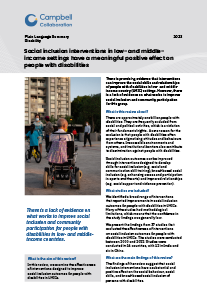
- See the full review https://doi.org/10.1002/cl2.1316
-
English
PLAIN LANGUAGE SUMMARY
Social inclusion interventions in low- and middle-income settings have a meaningful positive effect on people with disabilities
There is promising evidence that interventions can improve the social skills and relationships of people with disabilities in low- and middle-income country (LMIC) settings. However, there is a lack of evidence on what works to improve social inclusion and community participation for this group.
What is this review about?
There are approximately one billion people with disabilities. They are frequently excluded from social and political activities, which is a violation of their fundamental rights. A core reason for the exclusion is that people with disabilities often experience stigmatising attitudes and behaviours from others. Inaccessible environments and systems, and institutional barriers also contribute to discrimination against people with disabilities.
Social inclusion outcomes can be improved through interventions designed to develop skills for social inclusion (e.g. social and communication skill training), broad-based social inclusion (e.g. enhancing access and participation in sports and the arts) and improved relationships (e.g. social support and violence prevention).
What is the aim of this review?
In this review, we examine the effectiveness of interventions designed to improve social inclusion outcomes for people with disabilities in LMICs.
What studies are included?
We identified a broad range of interventions that reported improvements in social inclusion outcomes for people with disabilities in LMICs. Many of the studies had methodological limitations, which means that the confidence in the study findings was generally low.
We present the findings from 37 studies that evaluated the effectiveness of interventions on social inclusion outcomes for people with disabilities in LMICs. The studies were conducted between 2000 and 2022. Studies were conducted in 16 countries, with 12 in India and six in China.
What are the main findings of this review?
The findings of the review suggest that social inclusion interventions have a substantial and positive effect on the social behaviour, social skills, and broad-based social inclusion of persons with disabilities.
A moderate effect was reported from interventions designed to improve relationships between people with disabilities and their families and communities.
What do the findings of the review mean?
This review highlights promising evidence on the effectiveness of interventions to improve the social inclusion of people with disabilities.
Evidence on interventions for people with disabilities has, however, been primarily focused on interventions at the individual level, such as enhancing social skills and relationships.
There is a gap in evidence on community-level interventions that address societal barriers to inclusion, such as stigma reduction, and system-level interventions that improve legislation, infrastructure and institutions.
How up-to-date is this review?
The review authors searched for studies up to March 2022.
Additional Info
- Authors Emma Reith-Hall, Paul Montgomery
- Published date 2023-02-23
- Coordinating group(s) Social Welfare
- Type of document Review Plain language summary
- Title Communication skills training for improving the communicative abilities of student social workers
-
Library Image

- See the full review https://doi.org/10.1002/cl2.1309
-
English
PLAIN LANGUAGE SUMMARY
Communication skills training helps improve how social work students interact with the people they safeguard and support
Communication skills training, including empathy training, can help social work students to develop their communication skills. Opportunities to practise communication skills in a safe and supportive environment through role-play and/or simulation, with feedback and reflection, helps students to improve their skills. The effect of doing this training face-to-face, online or via blended learning is largely unknown.
What is this review about?
Good communication skills are important for social work practice and are commonly taught on social work qualifying courses. There is a range of different types of educational interventions, with wide variations in theoretical basis, approach, duration and mode of delivery. This systematic review looks at whether different interventions are effective in producing the following outcomes: social work students’ knowledge, attitudes, skills and behaviours.
What is the aim of this review?
This Campbell systematic review assesses whether communication skills training for social work students works, and which types of communication skills training, if any, were more effective and led to the most positive outcomes.
What studies are included?
This review summarises quantitative data from randomised and non-randomised studies. The 15 studies included in this review were undertaken in Canada, Australia and North America. The research is very limited in terms of scope and quality, and there are important weaknesses in the evidence base.
Does communication skills training improve the communicative abilities of social work students?
Systematic communication skills training shows some promising effects in the development of social work students’ communicative abilities, especially in terms of their ability to demonstrate empathy and interviewing skills.
What do the findings of the review mean?
Communication is very important for social work practice, so we need to ensure that student social workers have opportunities to develop their communication skills.
Too few studies fully assessed student characteristics such as age, sex and ethnicity or took account of how previous experience, commitments and motivation affected students’ learning.
Consideration of stakeholder involvement and collaboration (such as by people with lived experience) was also lacking. Only the role of the educator was considered.
The studies were largely of poor quality and investigated many different implementation features, which made it difficult to draw any firm conclusions about what makes the teaching and learning of communication skills in social work education effective.
Researchers conducting studies into communication skills training should seek to carry out robust and rigorous outcomes-focused studies. They should also consider trying to see how and where these interventions might work, as well as understanding for whom they may be effective.
How up-to-date is this review?
The review authors searched for studies that had been published until 15 June 2021.
Additional Info
- Authors Fiona Campbell, Rebecca Whear, Morwenna Rogers, Anthea Sutton, Ellie Robinson-Carter, Jane Barlow, Richard Sharpe, Stuart Cohen, Louise Wolstenholme, Joanna Thompson-Coon
- Published date 2023-02-16
- Coordinating group(s) Ageing
- Type of document Plain language summary Evidence and gap map
- Title Non-familial intergenerational interventions and their impact on social and mental wellbeing of both younger and older people: A mapping review and evidence and gap map
-
Library Image
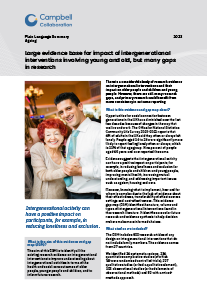
- See the full review https://doi.org/10.1002/cl2.1306
-
English
PLAIN LANGUAGE SUMMARY
Large evidence base for impact of intergenerational interventions involving young and old, but many gaps in research
There is a considerable body of research evidence on intergenerational interventions and their impact on older people and children and young people. However, there are still many research gaps, and primary research could benefit from more consistency in outcome reporting.
The interactive evidence and gap map (EGM) is available here.
What is this evidence and gap map about?
Opportunities for social connection between generations in the UK have diminished over the last few decades because of changes in the way that we live and work. The Office for National Statistics Community Life Survey 2020-2021 reports that 6% of adults in the UK said they often or always felt lonely. People aged 16 to 24 were significantly more likely to report feeling lonely often or always, which is 11% of that age group. Nine percent of people aged 65 years and over reported the same.
Evidence suggests that intergenerational activity can have a positive impact on participants, for example, in reducing loneliness and exclusion for both older people and children and young people, improving mental health, increasing mutual understanding, and addressing important issues such as ageism, housing and care.
However, knowing what to implement, how and for whom is complex due to the lack of evidence about their effectiveness, transferability of effects across settings and cost-effectiveness. This evidence gap map (EGM) identifies the nature, volume and types of intergenerational interventions found in the research literature. It identifies areas for future research and evidence synthesis to help decision makers make more informed choices.
What is the aim of this evidence and gap map (EGM)?
The aim of this EGM is to identify all the existing research evidence on intergenerational interventions to improve understanding about intergenerational activities in terms of the health and social care outcomes of older people, younger people and children, and to inform future research.
What studies are included?
The EGM includes 500 research articles of any design on intergenerational interventions that do not include family members. The evidence comes from 27 countries.
We identified 26 systematic reviews, 236 quantitative comparative studies (of which 38 were randomised controlled trials), 227 qualitative studies (or had a qualitative element), 105 observational studies (or had elements of observational methods) and 82 with a mixed-methods approach.
What are the main findings of this EGM?
The most commonly reported outcomes for children and young people were attitudes towards older people, knowledge and attainment, and intergenerational interactions.
For older people the most commonly reported outcomes were mental wellbeing, agency, attitudes towards younger people, and intergenerational interactions.
We identified several gaps in the research, including research on mutual, societal and community outcomes, young people’s mental health, loneliness, social isolation, peer interactions, physical health and health promotion, outcomes centred on caregiver wellbeing, mental health and attitudes, and adverse or unexpected outcomes, including economic outcomes.
Interventions were most commonly delivered in schools, in the community or in care homes.
Interventions most commonly involved activities related to sharing perspectives of being an older or younger person/child, spending time together, helping with chores, helping more generally within a school environment, mentoring, art and crafts to engage the generations together, learning or sharing music and playing games.
What do the findings of this EGM mean?
The EGM provides a starting point for researchers and decisionmakers to access the available research evidence on the effectiveness of intergenerational interventions.
The map demonstrates considerable diversity in the types of intergenerational activity. It also shows that it is mainly demonstration projects that are evaluated.
The quality of the evaluations makes analysis of their effectiveness, and hence their impact on shaping practice and policy, limited.
Methods of supporting useful evaluations of these types of interventions – so they are measuring meaningful outcomes – is needed. This EGM identifies many areas where there are still gaps in research.
How up-to-date is this EGM?
The authors searched for studies published up to July 2021.
Additional Info
- Authors Devi Leena Bose, Anhad Hundal, Sabina Singh, Shweta Singh, Kuhika Seth, Saif ul Hadi, Ashrita Saran, Jessy Joseph, Kriti Goyal, Solomon Salve
- Published date 2023-01-10
- Coordinating group(s) Social Welfare
- Type of document Plain language summary Evidence and gap map
- Title Social and behaviour change communication interventions for strengthening HIV prevention and research among adolescent girls and young women in low- and middle-income countries
-
Library Image
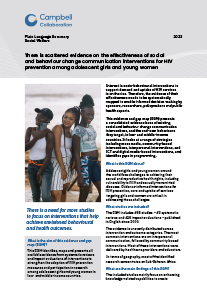
- See the full review https://doi.org/10.1002/cl2.1297
-
English
PLAIN LANGUAGE SUMMARY
There is scattered evidence on the effectiveness of social and behaviour change communication interventions for HIV prevention among adolescent girls and young women
Interest in socio-behavioural interventions to support demand and uptake of HIV services is on the rise. Therefore, the evidence of their effectiveness needs to be systematically mapped to enable informed decision-making by sponsors, researchers, policymakers and public health experts.
This evidence and gap map (EGM) presents a consolidated evidence base of existing social and behaviour change communication interventions, and the end-user behaviours they target, in low- and middle-income countries. It looks at a range of strategies including mass media, community-based interventions, interpersonal interventions, and ICT and digital media-based interventions, and identifies gaps in programming.
The interactive evidence and gap map (EGM) is available here.
What is this EGM about?
Adolescent girls and young women around the world face challenges to achieving their sexual and reproductive health rights, including vulnerability to HIV and sexually-transmitted diseases. Evidence-informed interventions for HIV prevention, care and uptake of services targeting girls and women are critical in addressing these challenges.
What is the aim of this evidence and gap map (EGM)?
This EGM identifies, maps and presents all available evidence from systematic reviews and impact evaluations of interventions to strengthen the adoption of HIV prevention measures and participation in research among adolescent girls and young women in low- and middle-income countries.
What studies are included?
The EGM includes 458 studies – 43 systematic reviews and 415 impact evaluations – published in English since 2000.
The evidence is unevenly distributed across intervention and outcome categories. The most common interventions are on interpersonal communication, followed by community-based interventions. Most of these interventions were delivered by healthcare providers and educators.
In terms of geography, most of the identified research concentrates on Sub-Saharan Africa.
What are the main findings of this EGM?
The included studies mainly focus on enhancing knowledge-related capabilities to create behavioural and health impacts. There is a need for more studies to focus on interventions that help achieve envisioned behavioural and health outcomes.
Few studies explore the effectiveness of these interventions across diverse groups – such as pregnant women and new mothers, sex workers and people living with HIV. This scarcity of research leads to a limited understanding of the use of these interventions across critical sub-populations and multiple user segments.
Given the value of communication channels in shaping behaviour change discourse, this EGM looks at evidence across different communication strategies and platforms. However, we found little evidence on the use of digital media tools such as social media and mobile-based services.
There are also relatively few studies on the use of popular culture tools – including mass-media, theatre and other arts-based approaches.
What do the findings of this EGM mean?
The EGM underscores the need for better quality evidence to understand what interventions work, for whom, and towards what outcome.
How up-to-date is this EGM?
The authors searched for studies published up to April 2021.
Additional Info
- Authors Áine Aventin, Martin Robinson, Jennifer Hanratty, Ciara Keenan, Jayne Hamilton, Eimear Ruane McAteer, Mark Tomlinson, Mike Clarke, Friday Okonofua, Chris Bonell, Maria Lohan
- Published date 2023-01-13
- Coordinating group(s) International Development
- Type of document Review Plain language summary
- Title Involving men and boys in family planning: A systematic review of the effective components and characteristics of complex interventions in low- and middle-income countries
-
Library Image
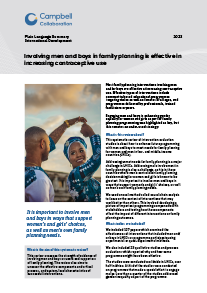
- See the full review https://doi.org/10.1002/cl2.1296
-
English
PLAIN LANGUAGE SUMMARY
Involving men and boys in family planning is effective in increasing contraceptive use
Most family planning interventions involving men and/or boys are effective at increasing contraceptive use. Effective types of interventions include community-based educational programmes targeting males as well as females of all ages, and programmes delivered by professionals, trained facilitators or peers.
Engaging men and boys in enhancing gender equality for women and girls as part of family planning programming was highlighted as key, but this remains an under-used strategy.
What is this review about?
This systematic review of intervention evaluation studies is about how to enhance future programming with men and boys to meet needs for family planning for women and men in low- and middle-income countries (LMICs).
Addressing unmet needs for family planning is a major challenge in LMICs. Addressing male involvement in family planning is also a challenge, as it is in these countries where men’s control over family planning decisionmaking for women and girls is known to be greatest. It is important to involve men and boys in ways that support women’s and girls’ choices, as well as men’s own family planning needs.
We used a novel method called causal chain analysis to focus on the content of interventions that may work better than others. This involved developing a picture of important programming components with stakeholders and testing how these components affect the impact of different interventions on family planning outcomes.
What is the aim of this systematic review?
This review assesses the strength of evidence of involving men and boys as users and supporters of family planning. The review also aims to uncover the effective components and critical process- and system-level characteristics of successful interventions.
What studies are included?
We included 127 papers which examined the effectiveness of interventions that included men and/or boys in LMICs as programme participants using experimental or quasi-experimental methods.
We also included 23 qualitative studies and process evaluations which reported why and how some programmes might have been effective.
The studies were conducted worldwide in LMICs, over half in Africa. A third of the studies were conducted on programmes that made a special effort to engage males. Less than a quarter of the studies addressed gender inequality as part of the programme.
What are the main findings of this review?
When considered together, the interventions included in this review were effective in increasing contraceptive use. The most effective interventions are community-based educational programmes offered in schools, communities and homes or community facilities, and interventions involving multiple components, delivered by professionals, trained facilitators or peers to both males and females for over seven months. Brief programmes of less than three months are also effective.
Added to this, related implementation studies identified the importance of promoting gender-equitable attitudes and social norms for women and girls among men and women at the individual, wider family, community, health service and societal level as part of family planning programming.
Some studies also emphasised structural factors such as the importance of widening women’s access to education and labour markets.
What do the findings of this review mean?
A wide range of family planning interventions which involve men and boys in LMICs have shown efficacy in increasing contraceptive use.
The success of family planning programmes that involve men and boys is most often measured by contraceptive use to the relative neglect of other outcomes, such as met need for family planning, equitable family planning decisionmaking, or gender equality. Our analysis indicates some promising intervention characteristics, which are more effective in promoting contraceptive use than other characteristics.
Our qualitative analysis also highlights the under-used strategy of addressing gender equality attitudes and norms, from the individual to the structural level.
The findings of this review will be of interest to programme designers wanting to increase male engagement in family planning in gender-equitable ways. The review can also help in measuring programme efficacy beyond contraceptive use, to also include gender equality and met family planning needs.
How up-to-date is this Campbell review?
The review authors searched for experimental evaluations in August 2020 and ‘connected’ process evaluations and qualitative studies in June 2021.
Additional Info
- Authors Kevin Petersen, David Weisburd, Sydney Fay, Elizabeth Eggins, Lorraine Mazerolle
- Published date 2023-01-10
- Coordinating group(s) Crime and Justice
- Type of document Review Plain language summary
- Title Police stops to reduce crime: A systematic review and meta-analysis
-
Library Image
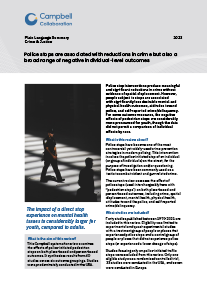
- See the full review https://doi.org/10.1002/cl2.1302
-
English
PLAIN LANGUAGE SUMMARY
Police stops are associated with reductions in crime but also a broad range of negative individual-level outcomes
Police stop interventions produce meaningful and significant reductions in crime without evidence of spatial displacement. However, people subject to stops are associated with significantly less desirable mental and physical health outcomes, attitudes toward police, and self-reported crime/delinquency. For some outcome measures, the negative effects of pedestrian stops are considerably more pronounced for youth, though the data did not permit a comparison of individual effects by race.
What is this review about?
Police stops have become one of the most controversial yet widely-used crime prevention strategies in modern policing. This intervention involves the police-initiated stop of an individual (or group of individuals) on the street, for the purpose of investigation and/or questioning. Police stops have been commonly used as a tactic to combat violent and gun-related crime.
The current review assesses the effect of police stops (used interchangeably here with “pedestrian stops”) on both place-based and person-based outcomes, including crime, spatial displacement, mental health, physical health, attitudes toward the police, and self-reported crime/delinquency.
What is the aim of this review?
This Campbell systematic review examines the effects of police-initiated pedestrian stops on both place-based and person-based outcomes. It synthesizes results from 40 studies across six outcome groupings. Studies were predominately conducted in the USA.
What studies are included?
Forty studies published between 1970-2021 are included in this review. Eligibility was limited to experimental and quasi-experimental studies with a treatment group of people or places that experienced police stops and a control group of people or places that did not experience police stops (or experienced a lower dosage of stops).
Studies focusing only on police-initiated traffic stops were excluded from this review. Only one eligible study was a randomized controlled trial, 33 studies were conducted in the USA, and seven were conducted in Europe.
What are the main findings of this review?
Police stop interventions lead to significant reductions in area-level crime with evidence of a diffusion of crime control benefits to nearby areas. However, methodological difficulties limit the strength of the causal inferences derived from these studies; further research is needed.
Individuals stopped by police are associated with significantly higher odds of both mental and physical health issues, significantly more negative attitudes toward the police, and elevated levels of self-reported crime/delinquency. The impact of a direct stop experience on mental health issues is also considerably larger for youth, compared to adults.
Despite this finding, place-based studies incorporating community surveys suggest that stop interventions do not impact community-level attitudes toward the police, and thus the negative effects of these interventions may be limited to the individuals directly experiencing them.
The findings of this review should be interpreted with caution, however, as only one randomized experiment assessing crime prevention outcomes was identified, and person-based studies were often unable to establish temporal ordering between the treatment and outcome measures.
What do the findings of the review mean?
Policing efforts focused on high-volume pedestrian stops are likely to reduce crime but may do so at the cost of negative health outcomes, negative attitudes toward the police, and higher levels of delinquency for individuals subject to the intervention. Given the net-widening effects of pedestrian stops (i.e., low proportions of stops lead to arrests or weapon seizures), these interventions may produce more harm than good. Police agencies should carefully weigh the potential benefits and harms associated with these interventions.
Furthermore, recent reviews on tactics such as hot spots policing and problem-oriented policing have demonstrated larger reductions in crime without similar backfire effects. The evidence-base for these tactics is also of considerably higher methodological rigor, generating stronger conclusions regarding program effectiveness. While it is possible that police agencies can mitigate the negative effects of pedestrian stops through a focus on improving officer conduct during police-citizen encounters, this review is unable to provide evidence of this effect.
How up-to-date is this review?
The authors of this review employed search strategies intended to capture studies through December 2021.
Additional Info
- Authors Nina T. Dalgaard, Anja Bondebjerg, Bjørn C. A. Viinholt, Trine Filges
- Published date 2022-12-07
- Coordinating group(s) Education
- Type of document Review Plain language summary
- Title The effects of inclusion on academic achievement, socioemotional development and wellbeing of children with special educational needs
-
Library Image
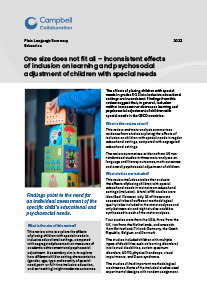
- See the full review https://doi.org/10.1002/cl2.1291
-
English
PLAIN LANGUAGE SUMMARY
One size does not fit all – inconsistent effects of inclusion on learning and psychosocial adjustment of children with special needs
The effects of placing children with special needs in grades K-12 into inclusive educational settings are inconsistent. Findings from this review suggest that, in general, inclusion neither increases nor decreases learning and psychosocial adjustment of children with special needs in the OECD countries.
What is this review about?
This review and meta-analysis summarises evidence from studies exploring the effects of inclusion on children with special needs in regular educational settings, compared with segregated educational settings.
The review summarises evidence from 15 non-randomised studies in three meta-analyses on language and literacy outcomes, math outcomes and overall psychosocial adjustment of children.
What is the aim of this review?
This review aims to explore the effects of placing children with special needs in inclusive educational settings, compared with segregated placement on measures of academic achievement and psychosocial adjustment. A secondary aim is to explore how different child or setting characteristics (gender, age, type and severity of special need, part- or full-time inclusive education, and co-teaching) might moderate outcomes.
What studies are included?
This review includes studies that evaluate the effects of placing children with special educational needs in mainstream educational settings (inclusion). A total of 94 studies were identified. However, only 15 of these were assessed to be of sufficient methodological quality to be included in the meta-analyses and only between six and eight studies could be synthesized in each of the meta-analyses.
Four studies were from the USA, three from the UK, two from the Netherlands, and one each from Switzerland, Finland, Germany, the Czech Republic, Belgium and Denmark.
The studies included children with multiple types of disabilities such as learning disorders/intellectual disabilities, autism spectrum disorders, ADHD, physical handicaps, visual impairments, and Down syndrome.
The studies all had important methodological weaknesses. None of the included studies used experimental designs with random assignment.
What are the main findings of this review?
Results of the meta-analyses do not suggest any consistent positive or negative effects of inclusion on children’s academic achievement as measured by language, literacy and math outcomes, or on the overall psychosocial adjustment of children. The studies in the analysis demonstrated a wide range of both large positive and large negative effect sizes; and although the average effect sizes did favour inclusion, they were small and none were statistically significant.
How has this intervention worked?
Supporters of mainstreaming or inclusion claim that segregated educational placement causes stigmatisation and social isolation, which may have detrimental effects on the self-concept, social identity, and self-confidence of students with special educational needs.
On the other hand, opponents suggest that placement in general education classrooms may have adverse effects for children with special needs, especially if the time and resources allocated for individualisation and differentiation are not aligned with student needs.
In line with these opposing positions, the findings from this review suggest that while some children with special needs may benefit from inclusive educational placement, other children may benefit from traditional special education in a segregated setting. Unfortunately, it was not possible to explore the effects of different kinds of inclusive education for different kinds of children with special needs.
What do the findings of the review mean?
The overall effects of inclusion on the academic achievement and overall psychosocial adjustment of students with special needs are inconsistent. Our findings are very similar to the results of previous systematic reviews and meta-analyses, which include studies published before 2000. It is very unlikely that inclusion in general increases or decreases learning and psychosocial adjustment in children with special needs.
These findings point to the need for an individual assessment of the specific child’s educational and psychosocial needs rather than a one-size-fits-all approach to placement in special education.
Research should explore the effects of different kinds of inclusive education for different kinds of children with special needs, to expand the knowledge base on what works for whom.
How up-to-date is this review?
The review authors searched for studies up to 30 September 2021.
Additional Info
- Authors Syeda Kashfee Ahmed, David Jeffries, Anannya Chakraborty, Toby Carslake, Petra Lietz, Budiarti Rahayu, David Armstrong, Amit Kaushik, Kris Sundarsagar
- Published date 2022-11-25
- Coordinating group(s) International Development
- Type of document Plain language summary Evidence and gap map
- Title Teacher professional development for disability inclusion in low- and middle-income Asia-Pacific countries: An evidence and gap map
-
Library Image
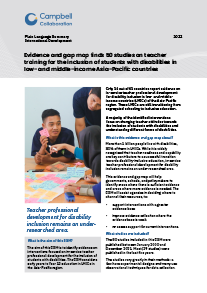
- See the full review https://doi.org/10.1002/cl2.1287
-
English
PLAIN LANGUAGE SUMMARY
Evidence and gap map finds 50 studies on teacher training for the inclusion of students with disabilities in low- and middle-income Asia-Pacific countries
Only 16 out of 41 countries report evidence on in-service teacher professional development for disability inclusion in low- and middle-income countries (LMICs) of the Asia-Pacific region. These LMICs are still transitioning from segregated schooling to inclusive education.
A majority of the identified interventions focus on changing teacher attitudes towards the inclusion of students with disabilities and understanding different forms of disabilities.
The interactive evidence and gap map (EGM) is available here.
What is this evidence and gap map about?
More than 1 billion people live with disabilities, 80% of them in LMICs. While it is widely recognised that teacher readiness and capability are key contributors to a successful transition towards disability-inclusive education, in-service teacher professional development for disability inclusion remains an under-researched area.
This evidence and gap map will help governments, schools and policymakers to identify areas where there is sufficient evidence and areas where more evidence is needed. The EGM will assist agencies in deciding where to channel their resources, to:
- support interventions with a greater evidence base
- improve evidence collection where the evidence base is weak
- re-assess support for current interventions.
What is the aim of this EGM?
The aim of this EGM is to identify evidence on interventions focused on in-service teacher professional development for the inclusion of students with disabilities. The EGM considers early years to Year 12 education in LMICs in the Asia-Pacific region.
What studies are included?
The 50 studies included in this EGM were published between January 2000 and December 2021. Most (29 studies) were published in the last five years.
The studies vary greatly in their methods: a few have experimental designs and many use observational techniques for data collection.What are the main findings of this EGM?
The included studies are unequally distributed across the intervention and outcome categories of the EGM. A significant number of interventions focus on changing teacher attitudes and understanding of disability, as many of these countries are in the early stages of the inclusive education agenda.
Only three studies discuss interventions for supporting mental health amongst students with a disability. One study reports an intervention to support students with physical disabilities where the teachers received training on mobility disability, as part of a larger teacher development programme.
Almost half of the 50 included studies are in mainstream school settings. None of the interventions identified support students with disabilities during emergency or crisis situations. This should be a key focus in the light of the current pandemic and widespread environmental disasters.
What do the findings of the map mean?
The evidence collated here is unevenly distributed and there is room for more studies in this space. The EGM highlights the following needs:
- Uptake of primary research using robust methods to measure intervention effectiveness and impact
- Interventions designed to support school mental health and psychosocial wellbeing for students with disabilities
- Support for education systems’ efforts on evidence synthesis through regional alliances and the formation of evidence hubs
How up-to-date is this EGM?
The authors searched for studies published up to December 2021.
Additional Info
- Authors Joseph Lee Betts, Elizabeth Eggins, Ned Chandler-Mather, Doug Shelton, Haydn Till, Paul Harnett, Sharon Dawe
- Published date 2022-11-03
- Coordinating group(s) Social Welfare
- Type of document Review Plain language summary
- Title Interventions for improving executive functions in children with foetal alcohol spectrum disorder (FASD)
-
Library Image
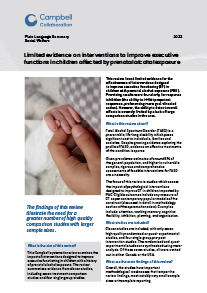
- See the full review https://doi.org/10.1002/cl2.1258
-
English
PLAIN LANGUAGE SUMMARY
Limited evidence on interventions to improve executive functions in children affected by prenatal alcohol exposure
This review found limited evidence for the effectiveness of interventions designed to improve executive functioning (EF) in children with prenatal alcohol exposure (PAE). Promising results were found only for response inhibition (the ability to inhibit prepotent responses, preferencing more goal-directed action). However, the ability to detect overall effects is severely limited by a lack of large comparison studies in the area.
What is this review about?
Fetal Alcohol Spectrum Disorder (FASD) is a preventable, life-long disability which poses significant cost to individuals, families and societies. Despite growing evidence exploring the profile of FASD, evidence on effective treatments of the condition is sparse.
Given prevalence estimates of around 5% of the general population, and higher in vulnerable samples, rigorous and comprehensive assessments of feasible interventions for FASD are a necessity.
The focus of this review is studies which assess the impact of psychological interventions designed to improve EF in children impacted by PAE. Eligible outcomes include any measure of EF as per contemporary popular models of the construct (discussed in detail in methodology section of the systematic review). Examples include: attention, working memory, cognitive flexibility, inhibition, planning, and organisation.
What is the aim of this review?
This Campbell systematic review examines the impact of interventions designed to improve executive functioning in children with a history of prenatal alcohol exposure. The review summarises evidence from eleven studies, including seven treatment-comparison studies and four single-group studies.
What studies are included?
Eleven studies are included, with only seven high-quality randomised or quasi- experimental studies, and four single group pre-post intervention studies. The randomised and quasi-experimental studies are synthesised using meta-analysis. Of these seven studies, all were carried out in either Canada or the USA.
What are the main findings of this review?
Overall, the studies have important methodological weaknesses that temper the review findings, most notably very small sample sizes or incomplete reporting.
While the pattern of results arising from the synthesis generally suggest positive intervention effects, the analyses did not reach statistical significance, aside from response inhibition. Response inhibition is the ability to inhibit behavioural responses in favour of goal-relevant behaviour, and this review found a medium-sized effect for children with PAE who participate in an EF-focused intervention compared to children who do not.
There appear to be no statistically significant differences between children with PAE who participated in EF interventions versus those who did not on the following direct measures of EF: auditory attention, visual attention, cognitive flexibility, attentional inhibition, verbal working memory or planning.
Similarly, there appear to be no statistically significant differences between children with PAE who participated in EF interventions versus those who did not on the following indirect measures of EF: global executive function, behavioural regulation, emotional control, shifting or inhibition.
What do the findings of the review mean?
Only a small number of eligible comparison group studies are included in the present analyses (n = 7), and it is likely that relatively small sample sizes hinder detection of effects across outcomes.
The findings of this review therefore illustrate the need for a greater number of high quality comparison studies with larger sample sizes. This will allow for more definitive conclusions to be drawn regarding the overall effectiveness of interventions for EF in children with FASD.
How up-to-date is this review?
The review authors searched for studies up to December 2020.
Additional Info
- Authors William Philbrick, Jacob Milnor, Madhu Deshmukh, Patricia Mechael
- Published date 2022-10-25
- Coordinating group(s) Social Welfare
- Type of document Plain language summary Evidence and gap map
- Title Information and communications technology use to prevent and respond to sexual and gender-based violence in low- and middle-income countries: An evidence and gap map
-
Library Image
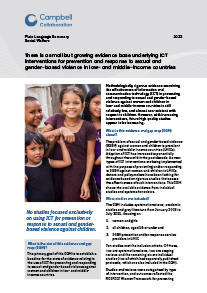
- See the full review https://doi.org/10.1002/cl2.1277
-
English
PLAIN LANGUAGE SUMMARY
There is a small but growing evidence base underlying ICT interventions for prevention and response to sexual and gender-based violence in low- and middle-income countries
Methodologically rigorous evidence examining the effectiveness of information and communication technology (ICT) in preventing and responding to sexual and gender-based violence against women and children in low- and middle-income countries is still relatively low, and almost non-existent with respect to children. However, with increasing interventions, future high quality studies appear to be increasing.
The interactive evidence and gap map (EGM) is available here.
What is this evidence and gap map (EGM) about?
The problem of sexual and gender-based violence (SGBV) against women and children is prevalent in low- and middle-income countries (LMICs). Adoption of ICT has increased exponentially throughout the world in the past decade. As new types of ICT interventions are being implemented with the purpose of preventing and/or responding to SGBV against women and children in LMICs, donors and policymakers have been looking for evidence based on rigorous studies that assess the effectiveness of such interventions. This EGM shows the available evidence from individual studies and systematic reviews.
What is the aim of this evidence and gap map (EGM)?
The primary goal of this EGM is to establish a baseline for the state of evidence relating to the use of ICT for preventing and responding to sexual and gender-based violence against women and children in low- and middle-income countries.
What studies are included?
The EGM includes systematic reviews, academic studies and grey literature from January 2005 to July 2021, focusing on:
- women and girls
- all children, aged 18 or under and
- SGBV prevention and/or response service providers in LMIC
Ten studies met the inclusion criteria. Of these, two are systematic reviews, two are scoping reviews and the remaining six are individual studies (two of which had separately published protocols, which are also included in the EGM).
Studies and reviews were categorised by type of intervention, and outcomes reflected the RESPECT Women Framework for preventing violence against women (World Health Organization 2019) and the INSPIRE Seven Strategies for Ending Violence against Children (World Health Organization 2016).
What are the main findings of this EGM?
No studies focused on using ICT exclusively for children. There is some evidence of impact in the areas of using ICT:
- to influence gender norms related to SGBV prevention and/or response
- in the form of mobile applications to increase safety and security
- to collect evidence related to SGBV incidents and user perceptions of SGBV services.
What do the findings of this EGM mean?
The results indicate a need for more rigorous studies on using ICT for SGBV prevention and/or response conducted in LMICs.
Specific research gap areas include: using harmonized and standardized impact indicators, child-focused interventions, and studies explicitly linking how ICT contributes to intermediate outcomes related to SGBV (identified under the RESPECT and INSPIRE frameworks) and ultimately to prevention and response outcomes.
How up-to-date is this EGM?
The authors searched for studies published up to July 2021.


